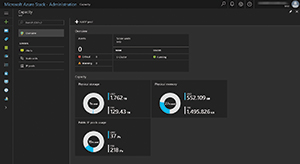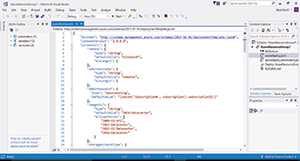In-Depth
First Look: Inside HPE's Azure Stack Appliances
Hewlett Packard Enterprise (HPE) was the first to invite Redmond magazine to test-drive Microsoft's new flagship hybrid cloud platform.
- By Paul Ferrill
- 12/05/2017
Among the four major vendors offering the first Azure Stack appliances that started shipping in October, Hewlett Packard Enterprise (HPE) was the first to invite Redmond magazine to test-drive Microsoft's new flagship hybrid cloud platform. Dell EMC and Lenovo have also shared details and configuration options with Redmond in demonstrations of Azure Stack at various conferences and meetings over the past two years, and HPE brought me to Microsoft's Customer Experience facility in Bellevue, Wash., so I could get hands-on with its new Azure Stack appliances.
This facility is home to two HPE Azure Stack systems, plus appliances offered by other vendors. In addition to Dell EMC and Lenovo, Cisco Systems is now taking orders for its Azure Stack appliance and Huawei is expected to begin shipping its first appliances next year. HPE offered a first-hand deep dive of hardware and initial release of the Azure Stack software by walking through a number of representative scenarios.
HPE Hardware
The HPE ProLiant DL380 is one of the most popular servers on the planet. HPE has sold a ton of these machines and uses them as the foundation for other products such as the HC 380 and the HPE SimpliVity 380. It's also one of the most flexible platforms with a huge number of possible configuration permutations. HPE recognized this as a possible confusion factor for customers looking at purchasing the Azure Stack product and reduced the options down to a manageable number.
A total of six CPU options range from the 12-core Intel Xeon E5-2650v4 up to the 22-core Intel Xeon E5-2699v4. Five memory options start at 256GB going up in increments of 128GB to a maximum of 768GB. Five storage options offer from 44TB to 88TB with mixtures of hard disks for bulk storage and solid-state drives for caching. Networking options are much more limited at this time although HPE does include other vendors such as Cisco should you choose to go that route.
HPE offers its Azure Stack product offering under what it calls Flexible Capacity. With this option you only pay for the capacity, both compute and storage, that you use in the same way that you currently use Azure. This is a relatively new offering and provides companies with an eye toward operational expenses (OpEx) over a huge capital expense (CapEx).
The company also offers a remote management service called Insight Remote Support (IRS). The IRS service allows HPE to perform predictive analysis on your Azure Stack system components and proactively perform maintenance should it determine a failure is imminent. Full support for all server and networking components is available with IRS.
Management Options
If you're comfortable with the Microsoft Azure portal you'll feel right at home with Azure Stack. The Azure Stack portal looks essentially the same as what you get in the Azure portal with the name changed (see Figure 1). From the dashboard page you have quick access to all available primary administration features. To view more detailed information, you can select one of the items like Capacity and view another screen (see Figure 2) with everything you need to know about the current state of your resources.
 [Click on image for larger view.]
Figure 1. The Azure Stack portal looks the same as the Azure portal.
[Click on image for larger view.]
Figure 1. The Azure Stack portal looks the same as the Azure portal.
 [Click on image for larger view.]
Figure 2. Administrative view of Capacity and resources available.
[Click on image for larger view.]
Figure 2. Administrative view of Capacity and resources available.
Monitoring the Azure Stack internal resources happens from the Administration page of the system (see Figure 3). From this page you can see all services and drill down into individual components such as the Compute controller shown. This function is spread across three different virtual machines (VMs) running on three different physical hosts (SRV02, SRV06 and SRV08). Should it be necessary, a single VM could be restarted from this page as shown.
For the system that was tested, called sys2, a total of eight physical nodes were configured in a single-scale unit cluster (see Figure 4). Individual physical nodes can be shut down using this screen to first move any running operations using the Drain button and then actually power down the node using the Power Off button. The link to the Base Management Controller allows the operator to drill down further into the HP iLO tool when necessary to further diagnose any hardware issues.
 [Click on image for larger view.]
Figure 3. Compute controller showing the state of virtual machines running on three different physical hosts.
[Click on image for larger view.]
Figure 3. Compute controller showing the state of virtual machines running on three different physical hosts.
 [Click on image for larger view.]
Figure 4. View of how eight physical nodes were configured into a single-scale cluster.
[Click on image for larger view.]
Figure 4. View of how eight physical nodes were configured into a single-scale cluster.
At a lower level you have access to the HPE OneView product for handling things like updating firmware for a RAID controller or Network Interface Card (NIC). It's also possible to perform power management operations through OneView instead of going directly to the individual node iLO address. This makes a lot of sense in a datacenter with hundreds of nodes.
Application Development
Microsoft has made a number of templates available from GitHub to help get you started developing for Azure Stack. While the end goal is to make the experience identical to what you get with Azure in the cloud, they aren't feature-compatible quite yet. To create a new project, you can select the Visual Studio Templates option from Visual Studio (see Figure 5).
After selecting that option, the resulting project from the deployment template appears (see Figure 6). This template could be modified to add additional VMs or change the OS with just a few changes. Using a template approach makes it simple to quickly change an environment to test out multiple configurations. It also makes it extremely simple to deploy a new instance of the environment once the template has been deployed successfully.
 [Click on image for larger view.]
Figure 5. Selecting the Visual Studio Templates option from Visual studio.
[Click on image for larger view.]
Figure 5. Selecting the Visual Studio Templates option from Visual studio.
 [Click on image for larger view.]
Figure 6. Resulting deployment from the Visual Studio template.
[Click on image for larger view.]
Figure 6. Resulting deployment from the Visual Studio template.
Overall Impression of the HPE Azure Stack
Microsoft has taken the crawl, walk, run approach to rolling out Azure Stack. It has come a long way since the technical preview release I looked at more than 18 months ago. Back then, Azure Stack was clearly at the crawl stage, and now the baby is just starting to stand up and try to walk. Yet, it's no surprise that while Azure Stack is early in the lifecycle of software, it's leveraging tons of experience provided by big brother Azure.
HPE has partnered with Microsoft to deliver a complete hardware and software solution to deploy Azure Stack in your datacenter. With the Flexible Capacity option, you can deploy Azure Stack without blowing your capital budget for the next five years. It provides the ability to select the right number of nodes from four up to 12 in increments of one. This gives you more options than some of the competitors offering nodes in multiples of four.
About the Author
Paul Ferrill, a Microsoft Cloud and Datacenter Management MVP, has a BS and MS in Electrical Engineering and has been writing in the computer trade press for over 25 years. He's also written three books including the most recent Microsoft Press title "Exam Ref 70-413 Designing and Implementing a Server Infrastructure (MCSE)" which he coauthored with his son.